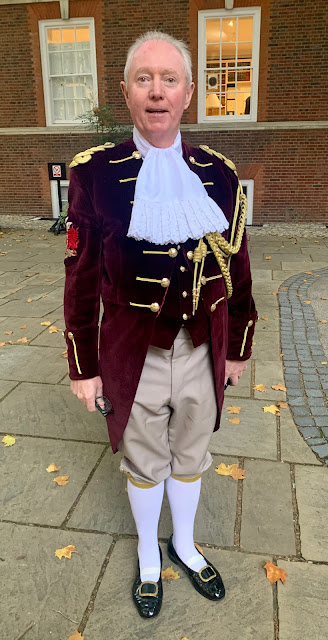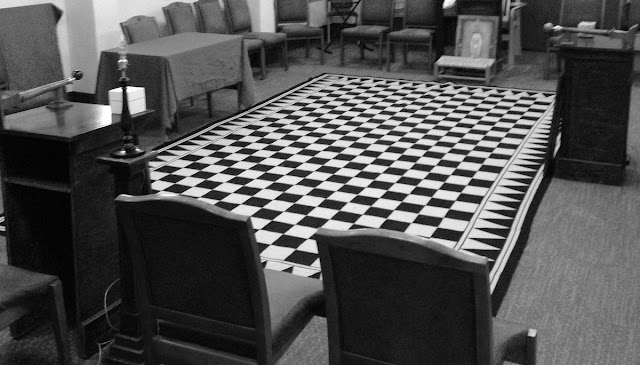The City Sheriffs and their Chain Gangs
There's a new Sheriff in Town (well two actually)
Any good cowboy and western film will feature that square jawed character who stands for law and order - the City Sheriff. In the wild west the Sheriff relied on his badge, his revolver, his horse, and a good dose of common sense to keep the peace. His office was usually next to the courthouse, and there were invariably cells for holding wayward townsfolk. This familiar trope of the spaghetti western finds it origins in the City of London where there are many parallels to be draw, but as ever the City of London likes to be different from other towns and elects two new Sheriffs to hold office every year, a right it has held since time immemorial.
Who were the first Sheriffs in London?
The office of Sheriff is undoubtedly the oldest in the City's vast treasure chest of ancient offices, it predates that of the Lord Mayor (1189), and the Aldermen (earliest record 1111). Its origins reach back before the Norman Conquest to Anglo-Saxon times, perhaps as far at the 7th century, when the Sheriff (Shire Reeve) was a royal official and the King's senior judicial officer in each of the ceremonial counties of England. Other styles of reeve existed throughout the kingdom including Town Reeve, High Reeve, Manor Reeve, etc.
By the time of the Norman Conquest the City had a Port Reeve (City Reeve) who is named in William I's charter of April 1067. It was the Port Reeves who ran the show and governed supreme until the City was granted the right of a Chief Magistrate styled Mayor, later Lord Mayor in the late 12th century.
The City of London is unique in having two Sheriffs, both elected by the Livery in Common Hall. In all other ceremonial counties in England, Wales and Northern Ireland the High Sheriffs are appointed by the Crown, or in the case of Cornwall by the Duke of Cornwall (currently HRH William, Prince of Wales), and in the case of Lancaster by the Duke of Lancaster (more popularly known as His Majesty the King).
From circa 1131 the citizens of London also had the right to farm the county of Middlesex on payment of an annual fee of £300 to the Crown, and to appoint their own Sheriff over that county. The two Sheriffs of London were also considered to be 'one' Sheriff over Middlesex until the Local Government Act came into effect in 1889 and a separate Sheriff for Middlesex was appointed by the Crown.
Who can become a Sheriff in the City of London?
To stand for election as a Sheriff in the City of London the candidate must be a Freeman of the City of London, and invariably one of the candidates for Sheriff is also an Alderman. While there is no legal requirement for either Sheriff to be a Liveryman, since the election is in the hands of the Livery it is exceptionally unlikely they would elect someone who was not also a highly respected and well-known Liveryman of long standing and good repute.
Every candidate to become a Sheriff will need an election agent, a campaign team, and a long list of supporters among the Livery who pledge to vote for them in Common Hall. No candidate for the following year may start campaigning until the elected Sheriffs take office. The usual rules apply regarding election campaign finances, and Sheriffs will find they need to get out and about among the Livery to get their message across.
Note: Some texts refer to the two Sheriffs as the Aldermanic Sheriff and the lay or non-Aldermanic Sheriff. This distinction does not exist in law. Both Sheriffs are styled the same, whether or not one or both are also Aldermen.
How are the Sheriffs elected?
The Sheriffs are elected on Midsummer's Day by a show of hands in Common Hall, that is the body politic of the Livery. The election is a direct contest but in the case of an Alderman standing for election he or she does so unopposed by any other Alderman. This is done because progression to the office of Lord Mayor requires that an Alderman must first serve as a Sheriff to 'tried as to their governance and bounty' in a ruling made by the Court of Common Council in 1385.
While the election is by acclamation, any two Liverymen may call for a ballot which must be conducted within 14 days of Common Hall.
What's the modern role of the Sheriffs?
The Corporation of London website provides a description of the role of the Sheriff for potential applicants which summarises the qualities that potential candidates must exhibit and outlines the role, but the reality of the role is more nuanced and richly embellished than any job description can convey.
In law the Sheriffs still have judicial powers, may execute writs and apprehend criminals, although these powers are no longer exercised directly by the Sheriff. In times past the Sheriffs were responsible for the protection of His Majesty's justices, i.e, the judges sitting in the central criminal court (the Old Bailey). Nowadays the Sheriffs open each court in a short ceremony every morning the judges are sitting.
It is the responsibility of the Sheriffs to invite interesting people from wider society to dine with the judges throughout the Sheriffs' year in office, thus ensuring the judges get to meet people from all walks of life, not just those who happen to arrive in the box before them. Who the Sheriffs invite is their own business, as is paying for their lunch!
The Sheriffs may be expected to deliver many speeches, attend all manner of civic, charitable, and livery events, and support the Lord Mayor throughout his or her year in office in various ways that make for an energetic, exciting and fascinating unpaid year out.
On a less happy note, it remains the personal responsibility of the Sheriffs to conduct any judicial execution should parliament legislate for a return to capital punishment. In times past the Sheriffs delegated that job to the common hangman and paid their fees.
How are the Sheriffs installed?
Once elected the Sheriffs have until late September to prepare for office, a process which may include petitioning for a grant of armorial bearings (a coat of arms), commissioning a shrieval badge based on their personal arms* and those of the livery companies of which they are a member, along with the logo of their ward. The Sheriffs will also need to obtain Court dress and prepare to move into their apartments in the Old Bailey.
The coats of petitioning for arms, commissioning a badge, and procuring ceremonial outfits and other accoutrements are considerable. For this reason it is a long-established custom that the Sheriffs supporters contribute toward these costs, coordinated by the campaign team or 'Chain Gang' as it has become known.
* In 2023 the elected Sheriffs both chose not to petition for arms until such time as heraldic convention (sometimes misleadingly styled heraldic 'law') is reformed to achieve equality of the sexes. This is the first known incidence of Sheriffs making such a decision. Nothing stops the Sheriffs petitioning for, and being granted, arms at a later stage.
When do the Sheriffs receive their Royal Warrants?
His Majesty retains the ultimate veto and has approximately 14 weeks from their election to stay the approbation of the Sheriffs should he find them unfit for office. Fortunately this never happens, the City having learned over many centuries the fine art and noble science of ensuring only the most wholesome candidates progress in a civic career.
The presentation of Royal Warrants to each of the Sheriffs is conducted in the Royal Courts of Justice in a ceremony presided over by the King's Remembrancer. The presentation is combined with the City's payment of rents for certain lands outside the City (see Quit Rents). Three copies of the Royal Warrants are produced, one for each Sheriff and a third which goes on display in the Old Bailey in the corridor behind the main court rooms.
In addition to the Royal Warrants, the coat of arms of past Sheriffs may be seen in the judges dining room in the Old Bailey. These date back only as far as 1905 although Sheriffs have probably been armigerous since the 13th century.
What's the badge of office of a Sheriff?
Unlike the familiar tin star badge of cowboy movie fame, the Sheriffs badge in the City of London is a unique creation that is personal to the individual. It has been generously described as a 'frolic' allowed to the Sheriffs and invariably blends symbolism and artistry at the hands of a master goldsmith. However it is not the badge but the chain from which it hangs that denotes the office of Sheriff,
 | ||||||||||||||
Every Sheriff commissions his or her own badge of office which traditionally combines coats of arms of their Livery Companies, their Ward and other affiliations. Badge of office of Alderwoman Dame Susan Langley. Photograph © Paul D Jagger 2023.
What are the Sheriffs' apartments like in the Old Bailey? No self-respective Sheriff lives far from the Court House or the lock-up, and so it is for the Sheriffs in London who have apartments in the Central Criminal Court (Old Bailey). A substantial refurbishment of the Sheriffs apartments was undertaken following the pandemic and now provide modern, spacious and comfortable, but not ostentatious accommodation for the Sheriffs and their partners. Sheriffs are expected to be resident in the Old Bailey most of their year in office, and especially so when the judges are sitting in Court. To defend the judges the Sheriffs are equipped with a court sword, and for those who do not possess one a selection of suitable swords is provided in their apartment.
The Sheriffs also benefit from access to the administrative support of the Old Bailey, a chauffeur and Rolls Royce Phantom VI. Each Sheriff has a footman to assist in domestic duties and at ceremonial occasions such as the Sheriffs' Breakfast and the Quit Rents.
Where are the Sheriffs steeds kept? While the Sheriffs do participate in an annual horse ride around the City, ably facilitated by the Light Cavalry of the Honourable Artillery Company, to raise money for the Lord Mayor's appeal, more modern conveyances are available to the Sheriffs in the City of London. The Old Bailey complex has its own covered parking area for the Sheriffs Rolls Royce Phantom VIs (one for each Sheriff). These are used on ceremonial occasions but for more practical City transport the Sheriffs benefit from an electrically powered London black taxi.
Want to learn more about the Livery Companies and the City of London? The City of London Freeman's Guide is the definitive concise guide to the City of London and its ancient and modern Livery Companies, their customs, traditions, officers, events and landmarks. Available in full colour hardback and eBook formats and now in its fifth or Platinum Jubilee edition. The guide is available online from Apple (as an eBook), Amazon (in hardback or eBook) Payhip (in ePub format) or Etsy (in hardback or hardback with the author's seal attached). Also available from all major City of London tourist outlets and bookstores. Bulk purchase enquiries are welcome from Livery Companies, Guilds, Ward Clubs and other City institutions and businesses.
I welcome polite feedback and constructive comment on all my blog articles. If you spot and error or omission, please do let me know (please illustrate with verifiable facts linked to an authoritative source where appropriate). I ask that all persons who wish to comment take the time to register as I receive copious spam and postings from crackpot conspiracy nuts which would otherwise overwhelm my blog with rubbish and nonsense. |













Comments
Post a Comment